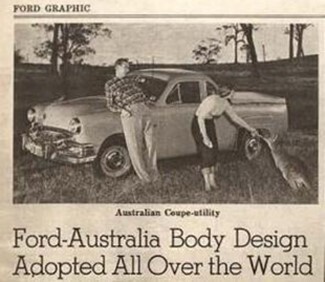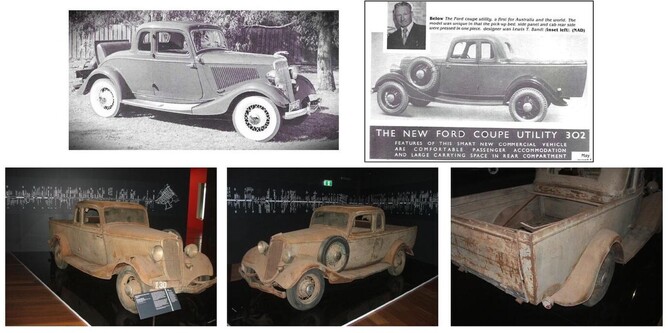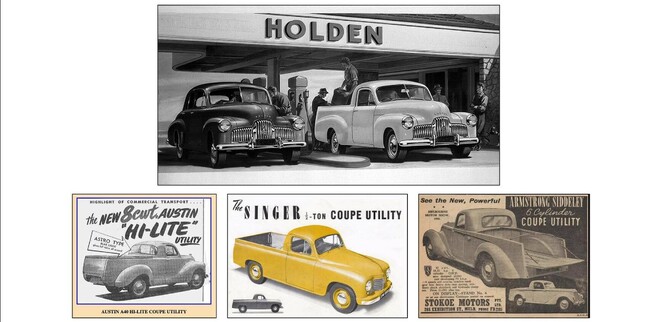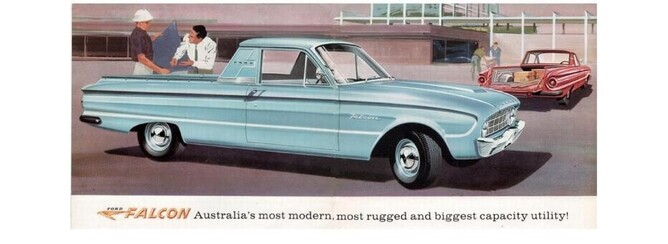Did Ford Australia really invent the ute?
That is a question that has caused much debate over recent decades. As the details of the story have been forgotten with the passage of time a broad-brush view has taken precedence. This has caused observers to comment that so-called utes existed long before the time the Australian’s claim to have invented it.
However, the fact remains that a chap named Lewis T Bandt is entitled to the moniker “Father of the Australian Ute”. Let’s look at those details.
Aged 19, Lew Bandt joined Ford of Australia in Geelong in 1929 as a junior body designer. This was an important role in the Australian motor industry because Australian carmakers were not just assemblers, they were also manufacturers. Back in 1917, the Australian government had legislated against the importation of built-up bodies for motor vehicles. The reason was two-fold: firstly, the war was on, this would save valuable cargo shipping space which could be better used for the war effort; secondly, the dying coachbuilding industry could be re-purposed to build bodies for motor vehicles. This explains why in 1925, when Ford of Australia was established, two companies were formed – one for sales, and the other for building the products to sell.
At first, the vehicles Ford-Australia was building were copies of those available from the parent company, Ford of Canada (and later, Ford of Britain). Increasingly variations in the designs and patterns would occur.
From very early in Ford’s history commercial vehicles were offered. One of the earliest was the Model T “Express”, which was essentially a chassis and a very basic body which often was made from the packing case in which the vehicle was delivered! (See photo, below left.) It was not much more than a buckboard. As the demand for commercial vehicles increased so did the variety of utilitarian uses they could be put to. So, for efficiency, Ford decided to offer a bare chassis (see photo, below right,) to which a local body builder could add a bespoke commercial body as required.
But there was one commercial utility body style that Ford continued to offer in their catalogues. During the later Model T era, the boot of a two-door Runabout could be replaced with a tin tray. That was known as the Pickup. This continued with the Model A Ford, although the design of the rear of the two bodies was unique to each (see photos below). The Pickups were simple and functional – just rudimentary body styles built for light utility work. Other manufacturers were also building such vehicles and all were basic, soft-top variations on existing designs that had started out as cars.
Then, in the early 30's, an Australian farmer's wife reputedly wrote to Ford. Some say she wrote to Henry himself. Others say that she wrote to Ford-Australia. Lew Bandt says the letter was written not by the wife but by the farmer himself. Whatever the truth, the letter arrived on Mr Bandt’s body-design desk in Geelong.
In an interview for Restored Cars magazine in the 1970s, Lew Bandt says the letter came to the managing director of Ford-Australia, Hubert French. “Couldn’t you people at Ford’s build a vehicle for people like me on the farm?” The infamous letter asked Ford to offer a vehicle that had all the comforts of a closed car, which excluded weather and the outback dust, but which could still be used for farm work. Because Ford-Australia was a manufacturing company, such a request from a local was not so unrealistic.
We should also remember that, at that time - the early 30s - closed cars were still relatively novel. Up until the advent of safety glass in the very late 20s, motorists had shied away from them, for fear of what the shards of glass might do to them in the event of a crash. Hence the dominance of open cars until the very late 20s.
What else was happening in the world at the time? The early 30's was the height of the Great Depression. Going to church of a Sunday was an important part of society back then. Even if you were living in the dusty outback, it was a must-do each week and it was just as important to be seen looking clean and sharp, spick and span in your Sunday best. If one lived in the outback this may not have been so easy to do in an open vehicle. During the Depression money was tight, so buying a second vehicle to get you to church on a Sunday was not an option - and preserving one's clothing was just as important.
So our letter-writer’s suggestion to build a closed car that could also be used for farm work was a good one, and very timely. Ford would take the initiative.
“Mr French passed it (the letter) on to Tommy Lane (the Sales Director) who passed it to Slim Wessman (the Factory Superintendent), who passed it to me”, Lew Bandt explained.
So, when that letter landed on Lew Bandt's desk, he had free reign. To satisfy the letter-writer, he didn't choose an open Runabout or Rroadster to modify, but a closed Coupe (as shown below, left).
“It was drawn full size…” he told Restored Cars, “..in chalk on a 40 ft. blackboard, full side view, full front view, full rear view. If approval was given by the principals…”
Approval was given! Lew Brandt goes on. “Our first Coupe Utility was designed in October, 1933. After seeing the design, the chief (Slim Wissman, I suspect) said to get old Tom Curry, foreman of the pattern shop, and the two of you get busy and let’s see one.”
So the prototype was built. What the team had done was build a hybrid of a closed car, with all the comforts such a car provided, with a Pickup tray, except that the tray was integrated as part of the bodywork (as shown below, right). It looked more like a car than it did a truck!
When he first saw it Tommy Lane (remember, he’s the Sales Director) said “I want 400 of these by yesterday.”
But, what to call it?
This was an all-new body style. It was a coupe-style hardtop with integrated bodywork. It was neither a truck nor a pick-up – rather, it was more of a utilitarian car. The word “utility” was already commonly-used in the auto industry as a verb - but it was about to become a noun. Bandt chose the name of his new motor vehicle category - this would be the “Coupe Utility”.
Just as the banner under the photo (below right) of the very first example exclaims, the features of this “smart new commercial vehicle are comfortable passenger accommodation and large carrying space in the rear compartment”. And that is the essential difference between the open Pickup truck and the closed, car-like Utility.
The colour photos below are my own pics of the only known unrestored example of Lew Bandt's Ford Coupe Utility, which was on display in Melbourne in 2015.
Then what happened?
The first Coupe Utility production run was in 1934 and comprised 499 units. They sold fast. Indeed, ever since the Coupe Utility has been a volume seller. Ford’s competitors in Australia were quick to follow Ford, especially General Motors who also adapted their Chevrolet and Vauxhall cars as Coupe Utility offerings.
Post-war, many other Australian manufacturers were offering a Coupe Utility in their lineup. Austin offered it in A40 Devon form. The Singer SM was developed as a Coupe Utility. Possibly inspired by Ford-Australia marketing the upmarket Mercury in Coupe Utility form, Armstrong Siddeley also released a Coupe Utility version of their refined Lancaster car. They all shared the same integrated body design principle.
That body-style was indeed unique to Australia. Had the New Zealand economy not been so strictly controlled by successive governments through that era, they would have been just as popular in this country too - as subsequently they became.
In November, 1948 General Motors in Australia began production of the first Australian-made motor car, the Holden 48-215. In early 1951, little more than a year later, General Motors released a low-price Coupe Utility adaptation of the car, to be known as the Holden 51-2106. It looked rugged, it offered the versality of Ford's original Coupe Utility of 1934 – and it was very affordable. Unsurprisingly, the 51-2106 sold very well for GM-H. For Ford, the competition would now really heat up.
A 1953 Ford of Canada Golden Jubilee publication adds more to the story behind the advent of the Coupe Utility. “The design came about when passenger cars introduced a longer wheelbase, enabling easy conversion to light commercial vehicles. The design was developed at Geelong, mainly by three men (Bandt, Wessman and Curry). With this new body (style) they (the passengers) would have all the comforts of a sedan with the carrying capacity of a light truck – all in one vehicle. The style has been copied by many other companies, not only in Australia but in many other countries around the world.”
In 1955, in response to the lead the home-grown Holden was taking in the new vehicle market, Ford of Canada approved plans for Ford-Australia to also build their own car, due for release in 1960. In preparation, manufacturing was expanded at Geelong. The first product from that expansion came In 1956, when Ford introduced the Mainline Coupe Utility, based on the Ford Customline passenger car. But the Mainline used a more rigid chassis from the American convertible, imported from Canada, and this large and solid offering from Ford went some way towards countering Holden’s lead. Indeed, Ford New Zealand imported the Mainline for assembly at Seaview, and that is documented in the Ford in New Zealand book - see Driving Ahead. The Mainline Coupe Utility continued in production in Australia until 1959.
Following the introduction of the second iteration of the British-sourced Zephyr, the Mark II, Geelong adapted it as a Coupe Utility. (And, while they were at it, Geelong also produced a station wagon version – the Australian estate body was built from scratch as an estate, unlike that offered by Ford of Britain, which started out as a sedan and was converted by coachbuilders Abbott of Farnham. Thereby Ford of Australia built station wagons inhouse even before their British counterpart!) The Zephyr and Consul Coupe Utility was not produced in big numbers as it still could not compete on price against the Holden equivalent. But, all that was about to change.
In 1960, Ford of Australia released the locally-made Falcon, the XK. In 1961 the Coupe Utility version of the Falcon was released to the market. It's appearance made the Holden look dated. In contrast, the sleek Falcon looked to be from the jet age, and it was an instance success. The Ford vs Holden sales battle would now rapidly step up in pace!
But, look at this.... Fotd's 1961 sales brochure for the Falcon (below) describes their latest release as “Australia’s most modern, most rugged and biggest capacity utility!”. Suddenly, the name of the Coupe Utility category had been shortened to just “utility”. Later, it would simply become the “ute”. But maybe it was the subtle dropping of the “coupe” word from the title in the early 60s that laid the foundation stone for the on-going debate of “who invented the ute”?
Fast forward a decade to Holden’s release of the HQ series. By now, these utility vehicle styles were all being referred to simply as “utes”. In the HQ line-up were two utility-style models (see photos below). One had unbroken sheet metal sides which, years earlier, would’ve been called the Coupe Utility. The other had rudimentary bodywork which finished at the back of the door – years earlier, that would’ve been called a Pickup. But times had changed. The first was simply a Holden ute and the second – the One-Tonner – was also a Holden ute!
Ford made a similar ute in the AU Falcon - and again, both were still just a "ute"!
However, this change in the use of language cannot alter the fact that Ford in Australia did indeed invent the Coupe Utility!









